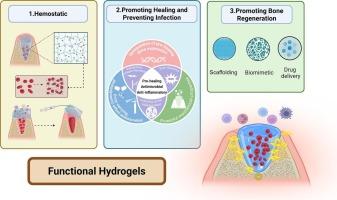Targeting post-extraction complications with functional hydrogels: Mechanistic insights, translational strategies, and clinical prospects
IF 11.5
1区 医学
Q1 CHEMISTRY, MULTIDISCIPLINARY
引用次数: 0
Abstract
Tooth extraction is a frequently performed dental procedure; however, the complex oral microenvironment can result in post-operative complications such as bleeding, infection, and delayed healing. Effective management of these issues requires a multidisciplinary strategy, with recent advancements in materials science and biotechnology introducing innovative solutions. Among various biomaterials, hydrogels are regarded as particularly suitable for post-extraction sockets due to their exceptional drug delivery capabilities, biocompatibility, and tunable physicochemical properties. This review systematically summarizes the latest progress in hydrogel-based strategies for managing common complications following tooth extraction. It emphasizes the preventative and therapeutic roles of functional hydrogels, details their advantages over traditional approaches, and explores their potential to improve clinical outcomes. Additionally, the unique physical and chemical properties of hydrogels—such as mechanical strength, swelling behavior, degradation rate, and injectability—are discussed, alongside their biological functions, including tissue regeneration, antibacterial activity, and controlled drug release. It concludes by outlining future research directions for functional hydrogels in post-extraction socket management and considers the challenges associated with their clinical transformation.

针对拔牙后并发症的功能水凝胶:机制见解,转化策略和临床前景
拔牙是一项经常进行的牙科手术;然而,复杂的口腔微环境可导致术后并发症,如出血、感染和延迟愈合。这些问题的有效管理需要一个多学科的战略,与材料科学和生物技术引入创新的解决方案的最新进展。在各种生物材料中,水凝胶因其特殊的药物输送能力、生物相容性和可调的物理化学性质而被认为特别适合于提取后的支架。本文系统总结了水凝胶治疗拔牙后常见并发症的最新进展。它强调了功能水凝胶的预防和治疗作用,详细说明了它们相对于传统方法的优势,并探讨了它们改善临床结果的潜力。此外,还讨论了水凝胶独特的物理和化学性质,如机械强度、膨胀行为、降解率和注射性,以及它们的生物功能,包括组织再生、抗菌活性和药物释放控制。最后概述了功能水凝胶在拔牙后眼窝管理中的未来研究方向,并考虑了其临床转化所面临的挑战。
本文章由计算机程序翻译,如有差异,请以英文原文为准。
求助全文
约1分钟内获得全文
求助全文
来源期刊

Journal of Controlled Release
医学-化学综合
CiteScore
18.50
自引率
5.60%
发文量
700
审稿时长
39 days
期刊介绍:
The Journal of Controlled Release (JCR) proudly serves as the Official Journal of the Controlled Release Society and the Japan Society of Drug Delivery System.
Dedicated to the broad field of delivery science and technology, JCR publishes high-quality research articles covering drug delivery systems and all facets of formulations. This includes the physicochemical and biological properties of drugs, design and characterization of dosage forms, release mechanisms, in vivo testing, and formulation research and development across pharmaceutical, diagnostic, agricultural, environmental, cosmetic, and food industries.
Priority is given to manuscripts that contribute to the fundamental understanding of principles or demonstrate the advantages of novel technologies in terms of safety and efficacy over current clinical standards. JCR strives to be a leading platform for advancements in delivery science and technology.
 求助内容:
求助内容: 应助结果提醒方式:
应助结果提醒方式:


